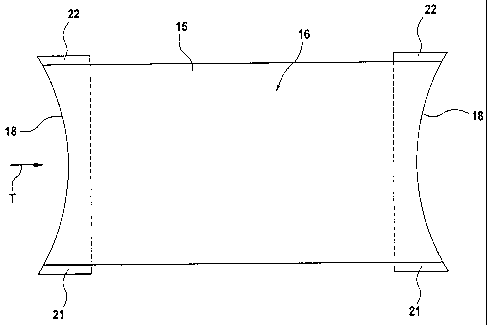Some of the information on this Web page has been provided by external sources. The Government of Canada is not responsible for the accuracy, reliability or currency of the information supplied by external sources. Users wishing to rely upon this information should consult directly with the source of the information. Content provided by external sources is not subject to official languages, privacy and accessibility requirements.
Any discrepancies in the text and image of the Claims and Abstract are due to differing posting times. Text of the Claims and Abstract are posted:
| (12) Patent: | (11) CA 2614040 |
|---|---|
| (54) English Title: | CONVEYING DEVICE |
| (54) French Title: | DISPOSITIF DE TRANSPORT |
| Status: | Granted and Issued |
| (51) International Patent Classification (IPC): |
|
|---|---|
| (72) Inventors : |
|
| (73) Owners : |
|
| (71) Applicants : |
|
| (74) Agent: | ROBIC AGENCE PI S.E.C./ROBIC IP AGENCY LP |
| (74) Associate agent: | |
| (45) Issued: | 2012-05-15 |
| (86) PCT Filing Date: | 2006-05-12 |
| (87) Open to Public Inspection: | 2007-01-18 |
| Examination requested: | 2008-04-11 |
| Availability of licence: | N/A |
| Dedicated to the Public: | N/A |
| (25) Language of filing: | English |
| Patent Cooperation Treaty (PCT): | Yes |
|---|---|
| (86) PCT Filing Number: | PCT/EP2006/004824 |
| (87) International Publication Number: | WO 2007006365 |
| (85) National Entry: | 2008-01-03 |
| (30) Application Priority Data: | ||||||
|---|---|---|---|---|---|---|
|
The invention relates to a conveying device substantially comprising an
endless conveying element (11) which is guided across several deflecting
elements (12) and is provided with a conveying sector (16) and a redirecting
sector (17). The conveying sector (16) defines a conveying plane E. The
conveying device further comprises a drive unit (13) for the conveying element
(11) as well as elements (14) for centering the conveying element (11). The
inventive conveying device is characterized in that at least the deflecting
elements (12a, 12b) located at opposite ends of the conveying sector (16) are
embodied as elements (14) which have an inward-oriented shape and are used for
centering the conveying element (11) perpendicular to the direction of travel
T.
L'invention concerne un dispositif de transport qui comprend principalement un élément de transport sans fin (11) guidé par l'intermédiaire de plusieurs éléments de renvoi (12) et pourvu d'un secteur de transport (16) et d'un secteur de retour (17), ledit secteur de transport (16) définissant un plan de transport (E), un entraînement (13) pour ledit élément de transport (11) ainsi que des éléments (14) destinés à centrer l'élément de transport (11). Ce dispositif de transport se caractérise en ce qu'au moins les éléments de renvoi (12a, 12b) placés aux extrémités opposées du secteur de transport (16) sont conçus en tant qu'éléments (14) destinés à centrer l'élément de transport (11) perpendiculairement au sens de transport (T) et présentant une forme dirigée vers l'intérieur.
Note: Claims are shown in the official language in which they were submitted.
Note: Descriptions are shown in the official language in which they were submitted.

2024-08-01:As part of the Next Generation Patents (NGP) transition, the Canadian Patents Database (CPD) now contains a more detailed Event History, which replicates the Event Log of our new back-office solution.
Please note that "Inactive:" events refers to events no longer in use in our new back-office solution.
For a clearer understanding of the status of the application/patent presented on this page, the site Disclaimer , as well as the definitions for Patent , Event History , Maintenance Fee and Payment History should be consulted.
| Description | Date |
|---|---|
| Inactive: COVID 19 - Deadline extended | 2020-04-28 |
| Common Representative Appointed | 2019-10-30 |
| Common Representative Appointed | 2019-10-30 |
| Change of Address or Method of Correspondence Request Received | 2018-12-04 |
| Grant by Issuance | 2012-05-15 |
| Inactive: Cover page published | 2012-05-14 |
| Pre-grant | 2012-02-29 |
| Inactive: Final fee received | 2012-02-29 |
| Notice of Allowance is Issued | 2012-01-11 |
| Letter Sent | 2012-01-11 |
| Notice of Allowance is Issued | 2012-01-11 |
| Inactive: Approved for allowance (AFA) | 2012-01-09 |
| Amendment Received - Voluntary Amendment | 2011-09-23 |
| Amendment Received - Voluntary Amendment | 2011-07-08 |
| Inactive: S.30(2) Rules - Examiner requisition | 2011-01-19 |
| Inactive: Correspondence - MF | 2010-08-10 |
| Inactive: IPC removed | 2010-02-23 |
| Inactive: First IPC assigned | 2010-02-23 |
| Letter Sent | 2008-05-22 |
| Request for Examination Received | 2008-04-11 |
| Request for Examination Requirements Determined Compliant | 2008-04-11 |
| All Requirements for Examination Determined Compliant | 2008-04-11 |
| Inactive: Cover page published | 2008-03-27 |
| Inactive: Notice - National entry - No RFE | 2008-03-25 |
| Letter Sent | 2008-03-25 |
| Inactive: Applicant deleted | 2008-03-25 |
| Inactive: First IPC assigned | 2008-01-26 |
| Application Received - PCT | 2008-01-25 |
| National Entry Requirements Determined Compliant | 2008-01-03 |
| Application Published (Open to Public Inspection) | 2007-01-18 |
There is no abandonment history.
The last payment was received on 2012-02-23
Note : If the full payment has not been received on or before the date indicated, a further fee may be required which may be one of the following
Please refer to the CIPO Patent Fees web page to see all current fee amounts.
Note: Records showing the ownership history in alphabetical order.
| Current Owners on Record |
|---|
| NORDISCHER MASCHINENBAU RUD. BAADER GMBH + CO. KG |
| Past Owners on Record |
|---|
| THOMAS GRABAU |